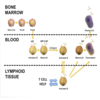Theme 2- week 2 Flashcards
(121 cards)
What are the main physiological functions of the immune system?
Recognise pathogens
Mount an immune response which requires- cell- cell communication
Clear the pathogen
Self-regulation
What is the innate immunity? Is it general or antigen specific? How fast is it? Does it remember antigens?
Innate immunity
General, not antigen specific but can recognise broad classes e.g. bacteria
Rapid speed of onset
Does not alter on repeated exposure
No memory
What is the adaptive immunity? Is it general or antigen specific? How fast is it? Does it remember antigens?
Adaptive immunity
antigen specific
Slower response, but more potent
Subsequent exposure- more effective response
memory
What are the responses of the immune system?
- nnate
- Barrier and chemical mechanisms
- Pathogen recognition
- Cellular
- Phagocytes Natural killer cells
- complement
- Adaptive
- Humoral (antibodies and B cells)
- Cellular
- B and T cells
Definiton of immunodeficency?
Clinical situations where the immune system is not effective enough to protect the body against infection
What is primary immunodeficency?
Primary- Inherent defect within the immune system- usually genetic
What is secondary immunodeficency?
Secondary- Immune system affected due to external causes
What are secondary causes of immunodeficency?
Breakdown in physical barriers: Cystic Fibrosis- compromised mucosal barrier which leads to recurrent infection
Protein loss
Burns, protein loosing enteropathy, malnutrition
Malignancy
Especially lymphoproliferative disease (disorder of lymph glands, spleen or bone marrow), myeloma (blood cancer from plasma cells in bone marrow)
Drugs
Steroids, DMARDS (disease modified antirheumatic drugs), Rituximab, anti-convultants (stops rapid firing of neurons during seizures), myelosuppressive (drug used before a bone marrow transplant to get rid of any cancer immune cells within the marrow)
Infection
HIV, TB
What do phagocytes do?
Neutrophils (short lived, migrate into tissues when needed, found in blood), macrophages (found in tissue and longer lived)
Eat bacteria, fungi à and then destroy them
Once bacterium ingested by phagocyte, endocytosed, phagosome binds with lysosome to form a phagolysosome, bacteria then destroyed and debris is exocytosed.
What are pathogen recognition receptors?
Pathogen recognition receptors (PRRs)- recognise conserved pathogen associated molecular patterns (PAMPs)- various types like TLRs, NLRs
What is in example of a PAMP?
Lipopolysaccharide is an example of a PAMP- present on bacteria
What do phagocytes use to detect pathogens?
Phagocytes use PRRs to detect pathogens
What are Toll like receptors?
Toll like receptors are a type of PRR
Examples of toll-like receptors and what they recognise?
Toll like receptors are a type of PRR
TLR4 – recognises lipopolysaccharide
TLR5- recognises Flagellin
What happens when TLR’s recognise?
Cascade of events involving various molecules intracellularly then production of inflammatory cytokines.
MyD88 and IRAK4 are involved in this cascade

Boy age 12 months :History of recurrent pneumococcal pneumonia
Investigations:
Normal levels of immunoglobulins, normal numbers of lymphocytes and neutrophils
CRP only marginally elevated during the infection- goes up in bacterial infection as stimulates liver to produce CRP
Clinical presentation:
- Recurrent bacterial infection, especially streptococcus and staphylococcus
- Pneumonia, meningitis, arthritis
- Poor inflammatory response
- Susceptibility to infection decreases with age
Treatment? What is the diagnosis?
- Rx: prophylactic antibiotics, iv immunoglobulin if severe
- MyD88 presents in a similar manner
Case 1 : IRAK4 deficiency
What can disorders of phagolysosomes lead to?
Phagolysosome- disorders of this can lead to a primary immunodeficiency
How do disorders of phagolysosomes lead to primary immunodeficency?
NADPH complex in phagolysosome- formed of several proteins including gp91phox (coded by the X chromosome)- releases an electron, binds to oxygens leading to a superoxide then produces hypochlorous acid (bleach that kills the bacteria/fungi)

6 years old boy
History of recurrent skin abscesses, 1 x previous pneumonia
Presented to hospital with a liver abscesses
Mothers brother-similar but milder symptoms
Investigations:
Normal immunoglobulins, lymphocytes and neutrophil count
Diagnosis?
Case 2: Chronic granulomatous disease
What causes chronic granulamatous disease?
Disease from an abnormality of gp91phox- encoded by the X chromosome- affects males and females carriers- collections of granulomas- collections of macrophages which go to the site of infection and can try engulf the bacteria but cannot destroy it

Symptoms of chronic granulamtous disease? What organisms cause it?
Recurrent abscesses: lung, liver, bone, skin, gut
Unusual organisms e.g. Staphylococcus, Klebsiella, Serretia, Aspergillus, Fungi
Rx: haemopoeitic stem cell transplant, antibiotics
What is the test for chronic granulamtous disease? What does it measure?
Tests rely on REDUCTION (gain of electron)
Neutrophil Function Test
Measure Dihydrorhodamine reduction using flow cytometry- molecule that you can measure if it released or not- can manipulate that- stimulate DHR- measure number of neutrophils reduced before and after stimulating the neutrophils
What colour should healthy neutrophils go after dye added in test?
Nitro blue tetrazolium dye reduction- healthy neutrophils should go purple
What are complements?
Non immunoglobulin proteins











